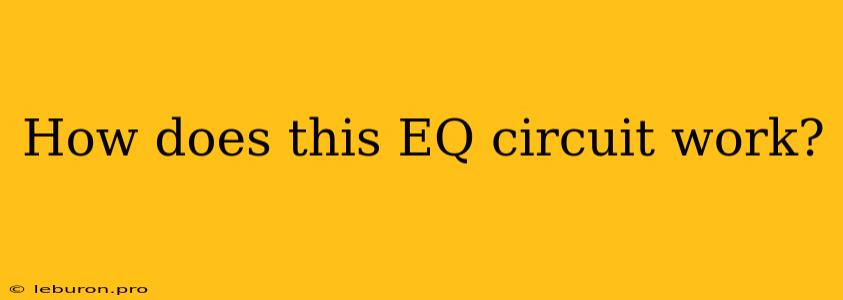Understanding the operation of an EQ circuit is crucial for audio engineers, music producers, and anyone involved in sound manipulation. Equalizers, commonly known as EQs, are essential tools for shaping the tonal characteristics of audio signals. They allow us to boost or cut specific frequency ranges, thereby enhancing the clarity, fullness, or punch of a sound. This article delves into the workings of an EQ circuit, exploring the fundamental components and principles behind its functionality.
The Building Blocks of an EQ Circuit
At its core, an EQ circuit relies on a combination of passive and active components to manipulate the frequency spectrum of an audio signal. The most common components used in EQ circuits include:
- Capacitors: These components act as frequency-dependent resistors, allowing high frequencies to pass through easily while blocking low frequencies. The reactance of a capacitor varies inversely with frequency.
- Inductors: Similar to capacitors, inductors exhibit frequency-dependent resistance. However, inductors are more effective at blocking high frequencies and allowing low frequencies to pass. The reactance of an inductor varies directly with frequency.
- Resistors: These components provide a fixed resistance, independent of frequency. They are used to control the gain and overall impedance of the circuit.
- Operational Amplifiers (Op-amps): Active components used to amplify the signal and introduce gain. Op-amps are crucial for active EQ circuits, as they allow for greater flexibility and control over frequency response.
Types of EQ Circuits
EQ circuits can be broadly classified into two primary types:
- Passive EQ Circuits: These circuits use only passive components like resistors, capacitors, and inductors to manipulate the frequency spectrum. Passive EQs are generally simpler to implement but have limited control over the frequency response. They typically offer fixed attenuation and gain characteristics.
- Active EQ Circuits: Active EQ circuits incorporate active components like operational amplifiers, which enable greater control over the frequency response. Active EQs offer variable gain and attenuation settings, allowing for more precise shaping of the audio signal.
How Does an EQ Circuit Work?
The operation of an EQ circuit relies on the principle of filtering. Filters are circuits designed to pass specific frequency ranges while attenuating or blocking others. The choice of filter type and its associated characteristics determine the overall frequency response of the EQ circuit.
Filter Types
EQ circuits employ various filter types to achieve different frequency shaping effects. Some common filter types include:
- Low-Pass Filter: This filter passes low frequencies and attenuates high frequencies. It is often used to remove unwanted high-frequency noise or to create a "warm" sound.
- High-Pass Filter: This filter passes high frequencies and attenuates low frequencies. It is often used to remove low-frequency rumble or to boost clarity and detail in recordings.
- Band-Pass Filter: This filter passes a specific band of frequencies while attenuating frequencies outside that band. It is used to isolate and enhance specific frequency ranges.
- Band-Stop (Notch) Filter: This filter attenuates a specific band of frequencies while passing frequencies outside that band. It is used to remove unwanted frequencies, such as hum or feedback.
Filter Order
The order of a filter refers to the steepness of its roll-off. A higher order filter results in a steeper roll-off, which means that frequencies outside the desired band are attenuated more effectively. First-order filters have a gentle roll-off, while higher-order filters exhibit a sharper transition.
Practical Applications of EQ Circuits
EQ circuits are widely used in various audio applications, including:
- Audio Recording: Equalizers are used to shape the tonal characteristics of instruments, vocals, and other sound sources during recording.
- Audio Mixing: In the mixing process, EQs are employed to balance individual tracks, create sonic space, and enhance the overall sound of a mix.
- Audio Mastering: Mastering engineers use EQ to fine-tune the final mix, ensuring consistent loudness and optimal frequency balance across different playback systems.
- Live Sound Reinforcement: Equalizers are essential for live sound systems to adjust the frequency response of speakers and microphones, compensating for room acoustics and ensuring optimal sound quality for the audience.
Conclusion
Equalizer circuits play a vital role in shaping the tonal characteristics of audio signals. By understanding the fundamental components and principles of EQ circuits, audio professionals can effectively manipulate the frequency spectrum to achieve desired sonic results. Whether it's removing unwanted noise, highlighting specific frequencies, or creating a balanced and pleasing sound, EQs remain essential tools in the world of audio engineering and music production.
